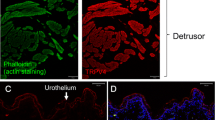Summary
The mechanism of Na+ transport in rabbit urinary bladder has been studied by microelectrode techniques. Of the three layers of epithelium, the apical layer contains virtually all the transepithelial resistance. There is radial cell-to-cell coupling within this layer, but there is no detectable transverse coupling between layers. Cell coupling is apparently interrupted by intracellular injection of depolarizing current. The cell interiors are electrically negative to the bathing solutions, but the apical membrane of the apical layer depolarizes with increasingI sc. Voltage scanning detects no current sinks at the cell junctions or elsewhere. The voltage-divider ratio, α, (ratio of resistance of apical cell membrane,R a, to basolateral cell membrane,R b) decreases from 30 to 0.5 with increasingI sc, because of the transportrelated conductance pathway in the apical membrane. Changes in effective transepithelial capacitance withI sc are predicted and possibly observed. The transepithelial resistance,R t, has been resolved intoR a, Rb, and the junctional resistance,R j, by four different methods: cable analysis, resistance of uncoupled cells, measurements of pairs of (R t, α) values in the same bladder at different transport rates, and the relation betweenR t andI sc and between α andI sc.R j proves to be effectively infinite (nominally 300 kΩ μF) and independent ofI sc, andR a decreases from 154 to 4 kΩ μF with increasingI sc. In the resulting model of Na+ transport in “tight” epithelia, the apical membrane contains an amiloride-inhibited and Ca++-inhibited conductance pathway for Na+ entry; the basolateral membrane contains a Na+−K+-activated ATPase that extrudes Na+; intracellular (Na+) may exert negative feedback on apical membrane conductance; and aldosterone acts to stimulate Na+ entry at the apical membrane via the amiloride-sensitive pathway.
Similar content being viewed by others
References
Bindslev, N., Tormey, J.McD., Pietras, R.J., Wright, E.M. 1974. Electrically and osmotically induced changes in permeability and structure of toad urinary bladder.Biochim. Biophys. Acta 332:286
Bonting, S.L. 1970. Sodium-potassium activated adenosinetriphosphatase and cation transport.In: Membranes and Ion Transport. E.E. Bittar, editor. Vol. 1, p. 257. Wiley Interscience, London
Brown, K.M., Dennis, J.E., Jr. 1972. Derivative free analogues of the Levenberg-Marquardt and Gauss algorithms for nonlinear least squares approximation.Numer. Math. 18:289
DiBona, D.R., Civan, M.M. 1973. Pathways for movement of ions and water across toad urinary bladder. 1. Anatomic site of transepithelial shunt pathways.J. Membrane Biol. 12:101
Edelman, I.S., Fimognari, G.M. 1968. On the biochemical mechanism of action of aldosterone.Recent Prog. Horm. Res. 24:1
Eisenberg, R.S., Johnson, E.A. 1970. Three-dimensional electrical field problems in physiology.Prog. Biophys. Mol. Biol. 20:1
Fettiplace, R., Andrews, D.M., Haydon, D.A. 1971. The thickness, composition and structure of some lipid bilayers and natural membranes.J. Membrane Biol. 5:277
Frömter, E. 1972. The route of passive ion movement through the epithelium ofNecturus gallbladder.J. Membrane Biol. 8:259
Frömter, E., Diamond, J.M. 1972. Route of passive ion permeation in epithelia.Nature, New Biol. 235:9
Handler, J.S., Preston, A.S., Orloff, J. 1972. Effect of ADH, aldosterone, ouabain, and amiloride on toad bladder epithelial cells.Am. J. Physiol. 222:1011
Higgins, J.T., Jr., Cesaro, L., Gebler, B., Frömter, E. 1975. Electrical properties of amphibian urinary bladder epithelia. 1. Inverse relationship between potential difference and resistance in tightly mounted preparations.Pfluegers Arch. 358:41
Higgins, J.T., Frömter, E. 1974. Potential profile inNecturus urinary bladder.Pfluegers Arch. 347:R32
Hviid Larsen, E. 1973. Effect of amiloride, cyanide and ouabain on the active transport pathway in the toad skin. Alfred Benzon Symposium V. N.A. Thorn and H.H. Ussing, editors. Munksgaard, Copenhagen
Koefoed-Johnsen, V., Ussing, H.H. 1958. The nature of the frog skin potential.Acta Physiol. Scand. 42:298
Lewis, S.A., Clausen, C.J., Diamond, J.M. 1975. A transport-related conductance pathway in frog skin and urinary bladder.Physiologist 18:291
Lewis, S.A., Diamond, J.M. 1976. Na+ transport by rabbit urinary bladder, a tight epithelium.J. Membrane Biol. 28:1
Lipton, P., Edelman, I.S. 1971. Effects of aldosterone and vasopressin on electrolytes of toad bladder epithelial cells.Am. J. Physiol. 221:733
Loewenstein, W.R., Socolar, S.J., Higashino, S., Kanno, Y., Davidson, N. 1965. Intercellular communication: Renal, urinary bladder, sensory, and salivary gland cells.Science 149:295
Macknight, A.D.C., Civan, M.M., Leaf, A. 1975a. The sodium transport pool in toad urinary bladder epithelial cells.J. Membrane Biol. 20:365
Macknight, A.D.C., Civan, M.M., Leaf, A. 1975b. Some effects of ouabain on cellular ions and water in epithelial cells of toad urinary bladder.J. Membrane Biol. 20:387
Reuss, L., Finn, A.L. 1974. Passive electrical properties of toad urinary bladder epithelium: Intercellular electrical coupling and transepithelial cellular and shunt conductances.J. Gen. Physiol. 64:1
Sharp, G.W.G., Leaf, A. 1973. Effects of aldosterone and its mechanism of action on sodium transport.In: Handbook of Physiology. Section 8, Renal Physiology. R. W. Berliner and J. Orloff, editors. p. 815. American Physiological Society, Washington, D.C.
Shiba, H. 1971. Heaviside's “Bessel Cable” as an electrical model for flat simple epithelial cells with low resistive junctional membranes.J. Theor. Biol. 30:59
Smith, P.G. 1971. The low-frequency electrical impedance of the isolated frog skin.Acta Physiol. Scand. 81:355
Socolar, S.J., Politoff, A.L. 1971. Uncoupling cell junctions in a glandular epithelium by depolarizing current.Science 172:492
Spenney, J.G., Shoemaker, R.L., Sachs, G. 1974. Microelectrode studies of fundic gastric mucosa: Cellular coupling and shunt conductance.J. Membrane Biol. 19:105
Ussing, H.H., Erlij, D., Lassen, U. 1974. Transport pathways in biological membranes.Annu. Rev. Physiol. 36:17
Walker, B.E. 1959. Radioautographic observations on regeneration of transitional epithelium.Tex. Rep. Biol. Med. 17:375
Author information
Authors and Affiliations
Rights and permissions
About this article
Cite this article
Lewis, S.A., Eaton, D.C. & Diamond, J.M. The mechanism of Na+ transport by rabbit urinary bladder. J. Membrain Biol. 28, 41–70 (1976). https://doi.org/10.1007/BF01869690
Received:
Revised:
Issue Date:
DOI: https://doi.org/10.1007/BF01869690




